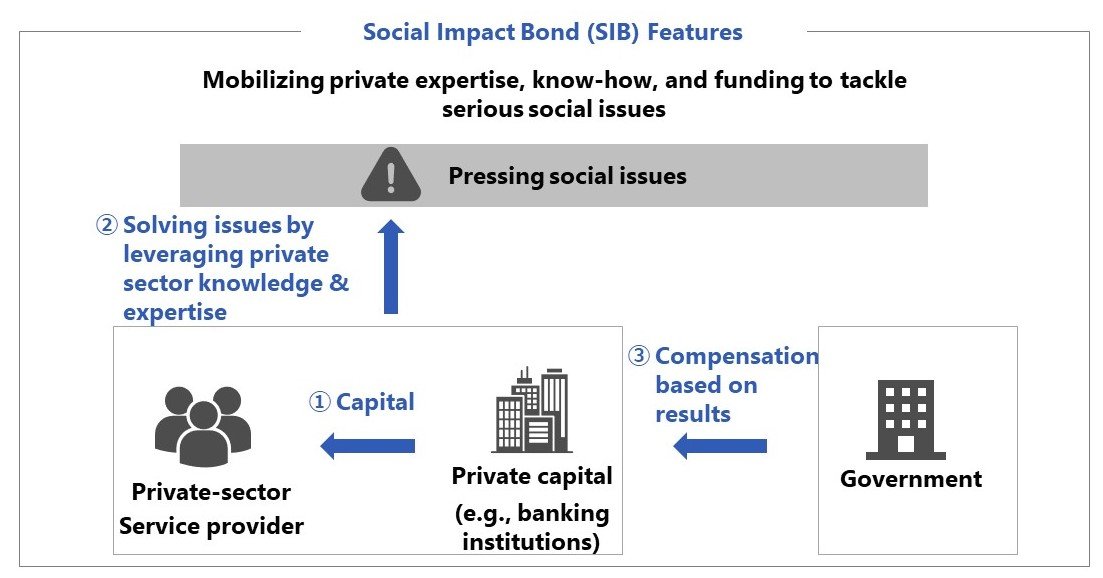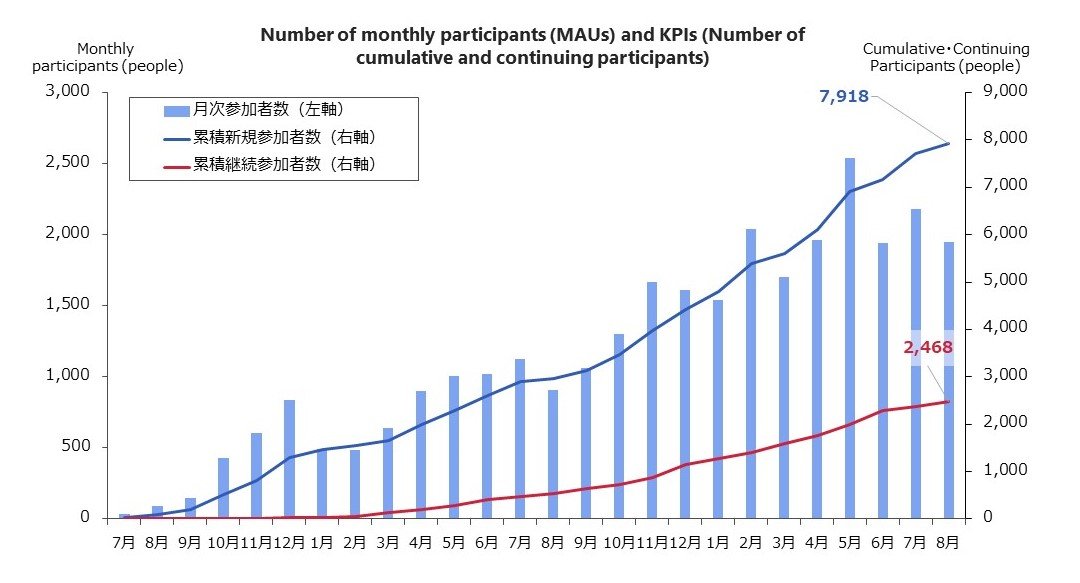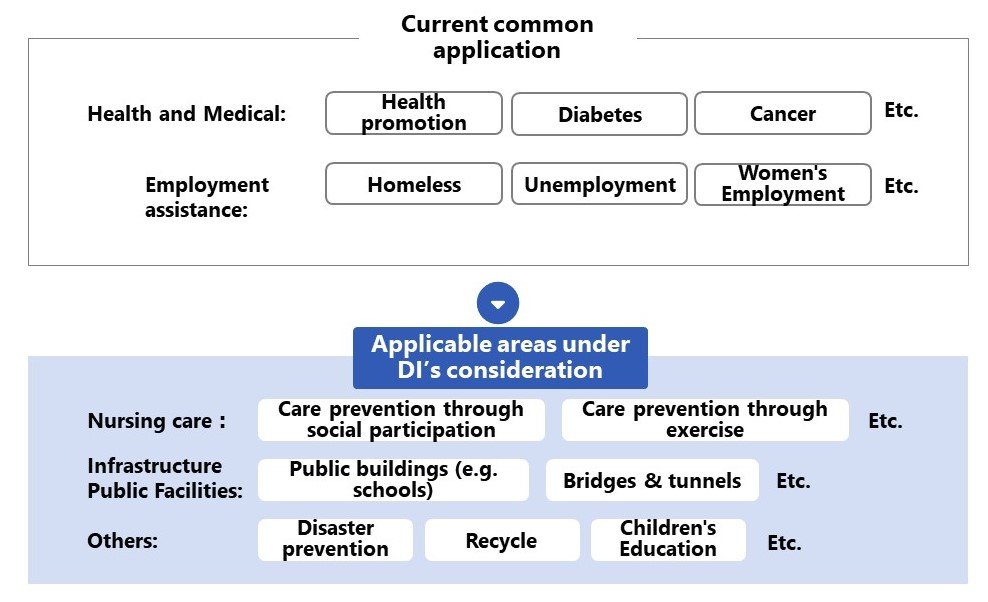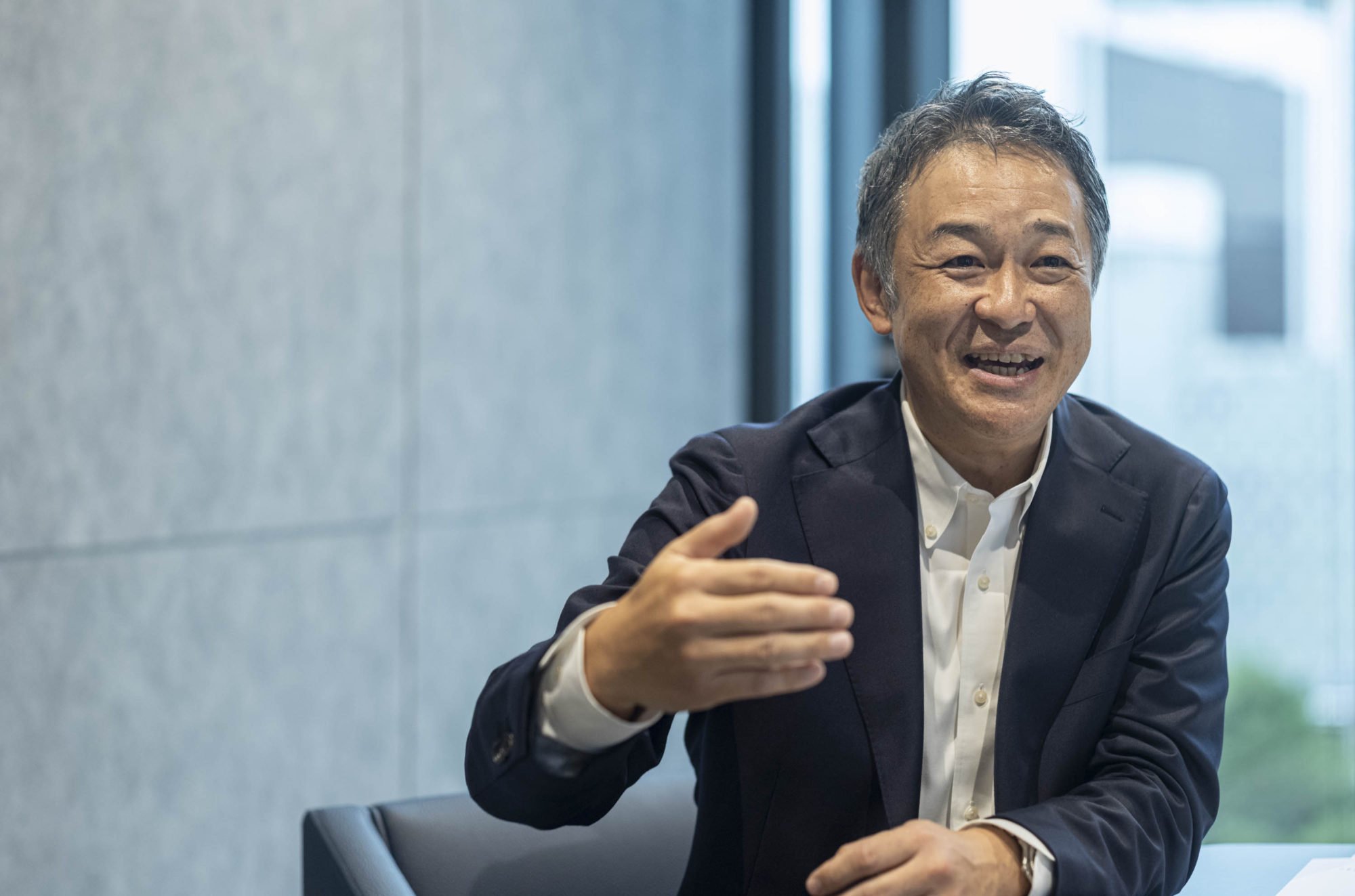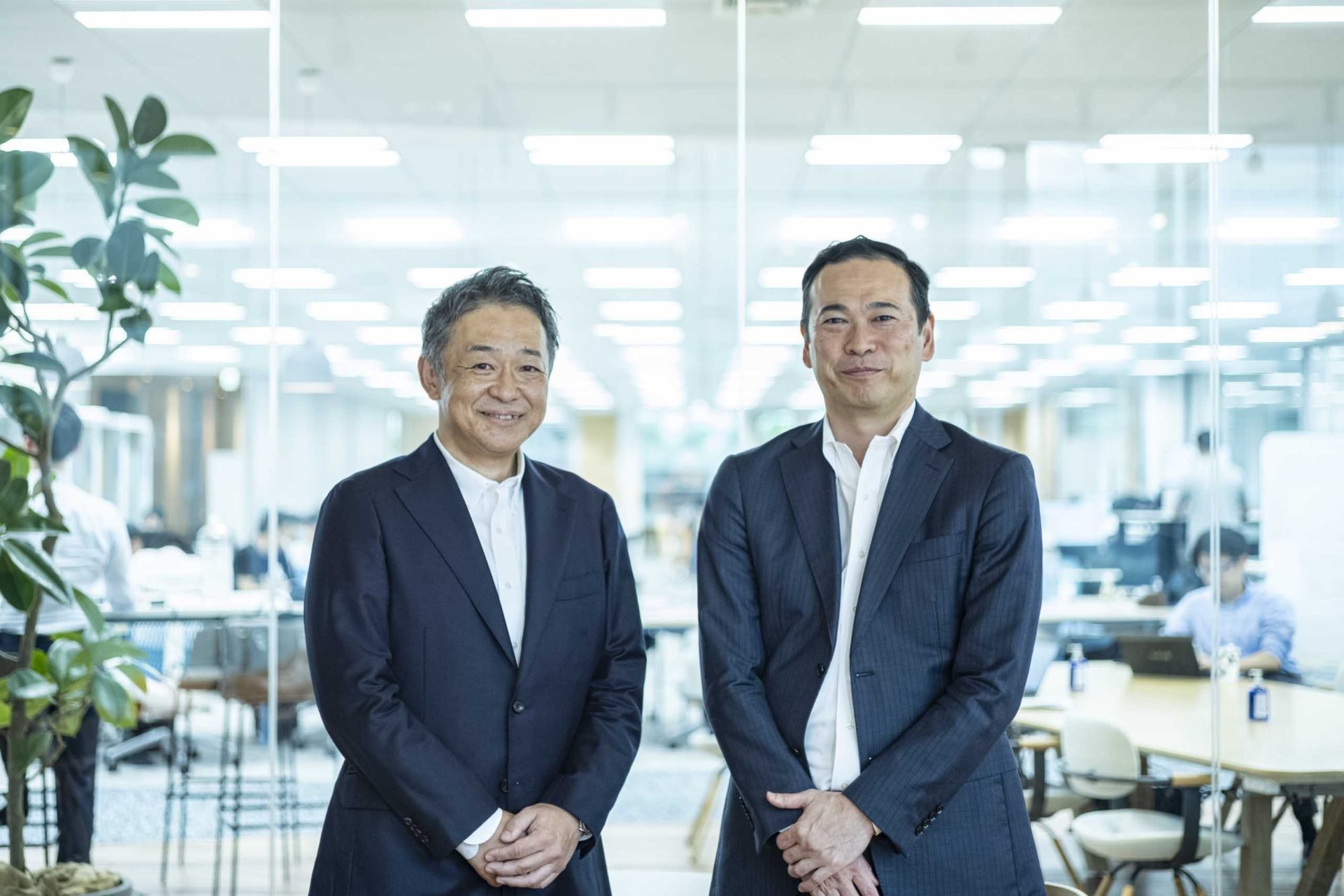DI’s Works Vol.6
An interview with Senior Executive Officer Masahito Ishikawa x Executive Officer Taiji Yoshida
Unraveling DI’s Industry Productions: The Current State and Future Perspectives of Social Impact Bonds (SIB) in Resolving Social Issues
At DI, we're dedicated to actualizing our mission of "Creating Businesses That Change Society" by engaging in industrial production to develop new businesses. In doing so, we have been advancing our first project utilizing the mechanism of Social Impact Bonds (SIB), a new approach for resolving social issues faced by national and local governments, which harnesses the expertise and funding of private enterprises, to achieve results through outcome-based implementation. We spoke with Masahito Ishikawa, who has been driving the first project, and Taiji Yoshida, who is currently striving to establish SIB schemes with seven municipalities nationwide in Japan, to learn about the current state and prospects of SIB.
● Senior Executive Officer Masahito Ishikawa
Ishikawa graduated from the Faculty of Science and Engineering, Waseda University, and completed his post-graduate studies at the same university’s Graduate School of Science and Engineering. Prior to joining DI, Masahito worked for Sumitomo Corporation. He is a founding member of DI’s business production initiative. Working with the government, he has engaged in the production of industries in the areas of environment/energy and community building, and developing strategies for achieving international expansion of Japan’s infrastructure industry. From 2010 to 2015, he led the establishment of DI Shanghai as its CEO, working on the development of strategies for Japanese companies’ expansion into China in a variety of sectors, and business production activities in collaboration with the Chinese government and government agencies. Since 2019, he has been engaging in study groups with the Ministry of Economy, Trade and Industry on the theme of SIB. He is currently overseeing Aichi Prefecture’s Toyota City elderly preventive care SIB "Zutto Genki! Project".
● Executive Officer Taiji Yoshida
Yoshida holds a Bachelor of Commerce, from Waseda University; a Master of Business Administration, from the University of Edinburgh; and a Master of Philosophy in Real Estate Finance from the University of Cambridge. He joined DI after working at Mitsubishi Bank (now Mitsubishi UFJ Bank), Macquarie Global Property Advisors (MGPA) (now BlackRock), and Renaissance Capital Group (RCGI). Leveraging extensive experience in finance, at DI, he has been engaging in "Social Issue Solutions x Finance" and managing the fund for SIB. He is also working on creating a new model for impact finance and tackling the resolution of social issues.
Introducing a New Scheme 'SIB' to Solve Social Issues
--- What prompted DI to embark on its efforts with SIB? Can you share the initiation of this endeavor?
Ishikawa:
"We at DI embrace the mission of "Creating Businesses That Change Society" and provide business production support to clients by delivering new value. Our business production is founded on the idea of creating new businesses based on solving social issues—'Industrial Production'—and formulating strategies to commercialize business concepts—'Business Production.' Under this approach, while DI is currently offering a variety of support, we also felt a sense of crisis that solely engaging in client work might lead to a depletion of our knowledge. Therefore, just like how manufacturers conduct research and development, we decided to engage in research and development activities ourselves."
"In 2019, we launched a study group with the Ministry of Economy, Trade and Industry to explore several themes to expand the possibilities for new businesses. Among these, the solution that stood out as the perfect fit for our goals was 'SIB = Social Impact Bonds.'
SIB, a government-led project utilizing private funds and expertise, shows immense potential as a novel approach to addressing social issues encountered by national and local governments. The combination of PFS (Pay For Success: Results-based private sector contracting method) with self-funding "financial" capabilities aligns well with DI's industrial production concept. This integration of different functions within established frameworks to tackle social issues plays to DI's strengths in creating new value.
--- What Is the Method for Addressing Social Issues Using SIB?
Ishikawa:
Despite our involvement in numerous social issue-solving projects, few examples are both beneficial to society and sustainable as businesses. Even when the work is praiseworthy, it often fails to generate profits. Through internal discussions, we identified a lack of effective money flow design as the root cause. This realization led us to recognize SIB as an effective method for facilitating the smooth circulation of funds.
For example, in Toyota City, Aichi Prefecture, nursing care has emerged as a significant social concern. In current preventive care initiatives, the cost of participation impacts the number of elderly participants. If the cost is too high, participation declines; if it is too low, the project's scale remains limited, posing profit challenges. Alternatively, if managed by local governments, programs could ease participant burden, but the current administration poses challenges to operating diverse programs.
Addressing these challenges, an SIB project has been initiated in Toyota City involving the city, its elderly population, program-providing businesses, a private coordination organization, and a fundraising function. DI established a fund and raised business funds, enabling businesses’ smooth program operations. Additionally, DI's subsidiary collectively manages and operates program-providing businesses, easing local government burdens. With 50+ programs from 40+ businesses, seniors benefit from high-quality programs, while businesses offer enhanced stability. This approach not only secures funding but also realizes numerous ideas. Local governments can then leverage private expertise and pay compensation based on the results of the project. We believe that there is a win-win relationship for all stakeholders involved in this care prevention scheme and that we can solve social issues through these activities, which is the true essence of DI's industrial production.
The Challenge of Unprecedented Precedents
--- What were the difficult points in your negotiations with Toyota City?
Ishikawa:
Defining success for this project is challenging, so we aimed to simplify the Key Performance Indicators (KPIs) that measure business results.
Specifically, we will use (1) participants, (2) continuers, and (3) the reduction in nursing care risk scores as indicators. (1) and (2) will be reflected through numbers, while (3) will involve comparing the scores of participants and non-participants through questionnaires. We also focused on minimizing operational effort.
Additionally, the Japan Gerontological Evaluation and Research Institute (JAGES) assesses the project's contribution to nursing care prevention.
Notably, the local government budget posed a significant challenge.
Yoshida: In the project with Toyota City, the goal was set to "reduce care costs by 10 billion yen with a budget of 5 billion yen." The funding structure of the long-term care insurance system originally covered 50% of the costs through insured individuals' premiums and the remaining 50% through public funds. The breakdown of public funds is as follows: national treasury subsidy 20%, adjustment subsidy 5%, prefectural burden 12.5%, and municipal burden 12.5%. This means that out of the intended 10 billion yen reduction in care costs, the city should have been responsible for only 12.5% of the 10 billion yen, which amounts to 1.25 billion yen. However, in this project, the municipality itself decided to invest 5 billion yen.
What is the significance of devoting a budget greater than the traditional long-term care insurance system to this project? Initially, the project was at a standstill as the significance of budget allocation was not apparent. It is understandable, as the project was designed to cost 5 billion yen, even though it should have only required a 1.25 billion yen contribution for the intended 10 billion yen cost reduction.
As DI, we negotiated budget allocation with the prefecture and national government for this unprecedented project but faced challenges in gaining consent. Consequently, by receiving corporate hometown tax donations from Mitsubishi UFJ Bank and others, we secured 500 million yen of the project budget planned by Toyota City. Using this corporate hometown tax donation system, donating companies can receive a tax deduction of up to 90% of the amount paid. This shift was a significant turning point for the project and exemplifies a characteristic DI approach. We express sincere gratitude to the donating companies. Ultimately, the use of this corporate version of the hometown tax donation system became a key driver in overcoming project stagnation.
The budget challenges are the same for the other seven local governments DI is currently collaborating. We are requesting companies and managers with ties to each city to contribute to the corporate hometown tax, aiming to secure the project budget through their cooperation.
Ishikawa:
The SIB project cannot begin without ambitious local governments and ambitious companies, and we at DI believe that we are the link between these two aspirations. We believe that this ambition and desire to make the world a better place will create a great deal of energy to solve social issues.
The Current Status of Toyota City's Initiatives and Future Development of SIB
---Please tell us about the current status of Toyota City's project, which is the key to deepening understanding of SIB
Since July 2021, we've been implementing the preventive care project in Toyota City utilizing the SIB system, providing varied programs for the elderly to encourage social engagement and ultimately reduce nursing care costs. By the end of June 2023, it has been two years since the project's commencement, with a five-year duration and a goal of 5,000 participants annually. Despite initial low visitation (2,600 to 2,700) in the first year, particularly due to the impact of the pandemic, we met the 5,000-participant goal in the second year, evidencing the project's taking root in the region.
● Toyota City Nursing Care Prevention Achievements (3 fiscal years)
---Please Share the Potential and Outlook of SIB Envisioned by DI
Ishikawa:
Until now, DI has been involved in industrial production and business production, launching new businesses for clients and guiding them to success. However, the SIB business is a completely new approach. That's why our first step is to make this project a success and then apply the knowledge gained in the process to other municipalities and future client work.
Understanding the gap between what we had in mind and the realization process is a valuable experience for business producers at DI. By leveraging our own experiences and the essence of DI, we aim to expand our presence in the world with this new scheme. Our ultimate goal is to spread further the understanding that solving social issues can become a business.
Yoshida:
In terms of expansion, Toyota City's theme is nursing care prevention, however, the SIB project has the potential to encompass additional themes, including measures against aging infrastructure and disaster prevention. We believe that addressing larger social issues can yield even greater benefits.
In response to the incident where a primary school student lost his life after being trapped under a concrete block wall during the Northern Osaka Earthquake, the government allocated 23.2 billion yen for a thorough inspection. It is believed that if preventive measures had been taken before the accident occurred, the associated costs could have been minimized. Most importantly, the life could have been saved.
If a local government cannot allocate money for unpredictable future events, finance takes on that uncertainty risk and expects a return that matches the risk taken. In other words, by forming funds and raising business capital, we invest in unaddressed social issues before they materialize, solve these issues, and yield a return. This is the key point and advantage of the SIB project. To demonstrate this as a result, DI hopes that Toyota City's project will pioneer the potential of SIB projects and serve as a trigger for more local governments to implement this mechanism.
---Finally, could you please share a message for those who are considering introducing SIB?
Yoshida:
The voices of regional creation and revitalization are echoing throughout the country, and SIB could be a good mechanism to make this a reality. This belief is not exclusive to DI alone.
Local financial institutions, rather than just handling money deposits and loans, believe that addressing the challenges faced by the community and returning benefits to the residents and businesses is an essential part of their role. Regional banks that invest in DI's funds are exactly doing this, as they are eager to address the community's social issues through SIB. We have actively collaborated with these local financial institutions to explain and negotiate SIB with local governments. We believe we have gained very strong allies in doing so.
Within this context, DI aims to create mechanisms and networks, fostering a momentum where local governments think, "We should also utilize SIB to address social issues!" We hope to contribute to many regions and societies through this approach.
Lastly, I'd like to share a story that goes beyond SIB. While we are currently working on preventive care SIB, we hope to expand this beyond the realm of preventive care and SIB, potentially giving rise to new industries. Let's call it the creation of a "health community industry." This community not only provides a place for activities and interaction aimed at maintaining the elderly’s health, but also new ideas are constantly being generated from the local government that provides the space, the businesses that operate there, and the local financial institutions that support these businesses. We aim to trigger community revitalization and the emergence of new industries through such initiatives.
Ishikawa:
When we look at the circle of SIB involving local governments, private funds, private businesses, service targets, and evaluation agencies, the mechanism itself seems functional and simple. However, in reality, smoothly operating it is quite challenging.
This is why the insights that DI has gathered through collaborating with various local governments and businesses become valuable. Nevertheless, if the SIB mechanism can only be realized by DI, it still has a long way to go in terms of addressing social issues.
The undertaking of this project stems from a desire for everyone in society to be happy, and the individuals in Toyota City have expressed hope for the proliferation of this model. Therefore, to address various social issues, DI aims to leverage its ability to generate concepts, build networks, and consolidate them into a business model, while also utilizing the strength of numerous allies and supporters. We want to pave the way for addressing not only caregiving but also other social issues.
Source (Japanese only) Link



